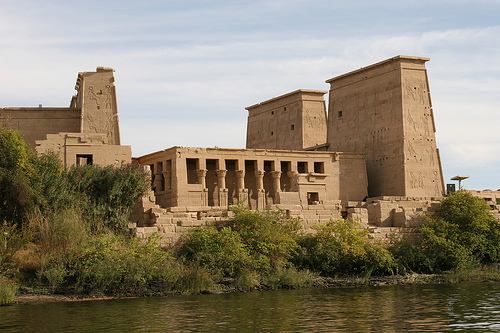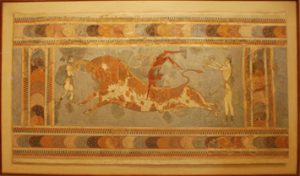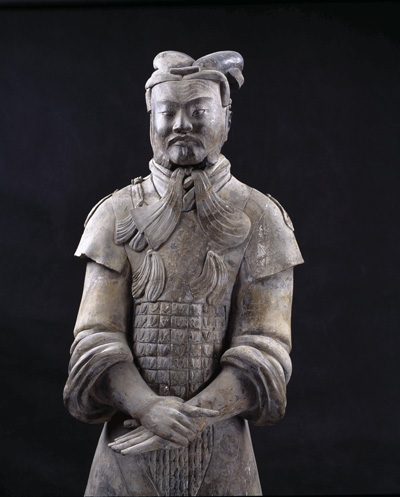Dr Michel Baud of the Louvre Museum in Paris gave an interesting lecture last week about his excavations of a pyramid at Abu Roash. The monument was badly preserved and its stone had been quarried in Roman times, but the certain details, such as its apparent solar connections, were still discernable. Earlier, Vassil Dobrev stated that the pyramid may actually be a solar temple. However, Baud dismisses these claims…. Nearly 4,500 years ago, in the time of the Old Kingdom, the pharaoh Khufu built one of the greatest monuments on earth – the Great Pyramid. His pyramid was actually a…
-
-
What can graffiti tellus about ancient cultures?That’s just one of the questions being explored at a Coptic Studies symposium to be held on May 29 at the University of Toronto. Coptic refers to the branch of Christianity that spread to Egypt as early as the first century AD. It also refers to a writing system that was in use from that time until present day. The symposium is being organized by Dr. Ramez Boutros of the University of Toronto. Dr. Boutroshas been in the news recently as part of the team that recently discovered a third church and tons of…
-
The opening weekend for the The Warrior Emperor and China’s Terracotta Army, is shaping up to be one filled with, well, warriors. The Royal Ontario Museumannounced recently that the exhibit, the largest Terracotta Warriors show ever to hit North America, will be opening on June 26. That day coincides with the opening of the G20 summit which runs from June 26-27 in Toronto. The leaders of the worlds 20 largest economies, including US President Barack Obama, will be attending meetings at the Metro Toronto Convention Centre. News is just breaking that the main protest zone islikely to be just steps…
-
A team of archaeologists, led by Professor Vance Watrous and Matt Buell of the University at Buffalo, have discovered a fortification system at the Minoan town of Gournia. The discovery rebukes the popular myth that the Minoans were a peaceful society with no need for defensive structures. That idea arose from work done in the early 20th century by Sir Arthur Evans who proposed that a pax Minoica existed on Crete during their time. Certainly the Minoans were afraid of somebody, Professor Watrous said. The town was originally excavated from 1901-1904 by Harriet Boyd Hawes, a pioneering women who was…
-
King Tut has left Toronto. The Tut exhibition – Tutankhamun: The Golden King and the Great Pharaohs – at the Art Gallery of Ontario wrapped up on Sunday after a blockbuster run. The final visitor total was about 400,000 people an impressivenumber but not as high as the 1979 show that drew 750,000 visitors. That show featured Tuts golden death mask, an artefact that no longer leaves Egypt. Despite the lower numbers the art gallery considers the show to be a success. “King Tut attracted 404,364 visitors, 47 per cent of whom were making their first visit to the AGO.…
-
One of the most perplexing mysteries that Egyptologists and Aegean experts are tackling is that of the frescoes of Tell el-Dab’a, also known as Avaris.This site was used as the capital of the Hyksos, at a time when they ruled much of Egypt, from 1640 – 1530 BC. It is on the Nile Delta and would have provided access to the Sinai, Levant and southern Egypt. The site appears to have been abandoned for a time after the Hyksos were driven out. However, by the end of the 18th dynasty (when the Egyptians were back in control of their land), the…
-
The story of Bronze Age Santorini (Thera) is one that has become a legend. Located between Crete and mainland Greece, this island supported a thriving civilization that reached its peak between 2000 1600 BC. Its main city, Akrotiri, had its own naval fleet and had trade connections throughout the Aegean and Near East. Its people produced beautiful frescoes thatdepicted everything from boxing matches toshipsand even antelopes. This civilization came to an abrupt end at some point in the late 17th century BC, when Akrotiri was devastated by earthquakes, causing the people to flee. Shortly thereafter a massive volcanic eruption occurred,…
-
New research, conducted by Dr. Amy Barron of the University of Toronto, is shedding light on the weapons and battle tactics used by the Assyrians during the first millennium BC. Assyria was a military powerhouse during this time. The empire they controlled stretched from modern day Iraq to the Mediterranean coast. They even managed to successfully invade Egypt, defeating the pharaoh Taharqa and installing rulers sympathetic to Assyria. But how did they do this? The Assyrian heartland was in central Iraq. Its not an area particularly rich in minerals or gold. There are few natural defensive pointsinthe area,making the task…
-
Heritage Key reported recently that mummified baboons in the British Museum could reveal the location of the land of Punt – a place to which pharaohsorganized trading expeditions. To theEgyptians, Punt was a placeof fragrances, giraffes, electrum and other exotic goods. It was sometimes referred to as Ta-netjer ‘Gods land’ a huge compliment given that the Ancient Egyptians tended to view outside cultures with disdain. Although Egyptians record voyaging to it until the end of the New Kingdom, 3,000 years ago, scholars do not know where Punt was. Ancient texts offer only vagueallusions to its location and no ‘Puntite’ civilization…
-
The Royal Ontario Museum will host afour day symposium called Life in the Afterlife at the same time that a giant Terracotta Warriors show will be on display at the museum. Life in the Afterlife will explore ideas on life after death across different cultures. Speakers will be talking about the afterlife in numerous places, including Ancient China, Egyptand the Near East. The symposium also examines China during the rule of Qin Shi Huang, the first emperor. The event is aimed at a popular audience. The keynote lecture will be given by journalist Simon Winchester who will be discussing Joseph…



